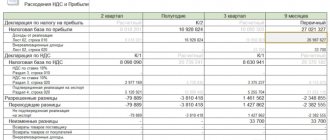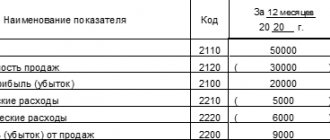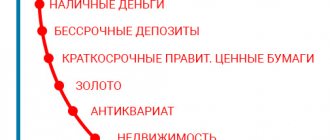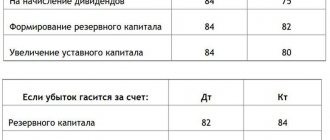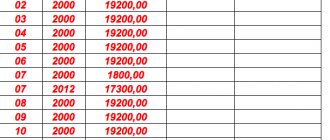Taxpayers submitted reports for 2015 and for the first quarter of 2016. And immediately for these two periods, requests from inspectorates began to pour in demanding clarification of the indicators reflected in the accounting and tax reporting. Inspectors also require the share of VAT deductions to be justified.
Many companies carefully explain everything that interests fiscal officials. However, is it really necessary to write detailed explanations in response to a request? Perhaps, even without them, there is a logical explanation for the notorious “discrepancies” in reporting. Individual indicators in declarations should not coincide at all. This means that there are no discrepancies and there is nothing to explain. Tax officials should be well aware of this.
The company that turned to me for help also received requests from fiscal officials demanding clarification of the indicators reflected in the reporting. The organization had many branches, so the number of requests coming from different inspections grew alarmingly. In this regard, there is a need to systematize all requests and requirements received.
The company's management decided to optimize the work of the accounting department. This was necessary in order to avoid copying unnecessary documents and writing unnecessary explanations. After all, everything took up a lot of working time. The management came to the conclusion that it was necessary to develop a unified approach to the formation of explanations for unlawful requests.
Is it necessary to explain the discrepancy between VAT and income tax?
The company received a request to provide clarifications in the form approved in Appendix No. 1 to the order of the Federal Tax Service of Russia dated 05/08/15 No. ММВ-7-2 / [email protected] The reason for sending the request was a desk audit. The fiscal authorities requested clarification on the indicators reflected in individual lines of the balance sheet (Appendix No. 1 to the order of the Ministry of Finance of Russia dated July 2, 2010 No. 66n). And they also demanded to attach documents confirming the reasons for the decrease in the “Financial Investments” indicator in the balance sheet asset.
But the Tax Code does not allow desk audits of financial statements! Controllers have the right to request documents and explanations on issues related to the calculation and payment of taxes (subclause 1, clause 1, article 31, articles 88, 93 of the Tax Code of the Russian Federation). And financial statements are necessary for users of these statements to make economic decisions (Part 1, Article 13 of Federal Law No. 402-FZ dated December 6, 2011).
In addition, the tax authorities monitor compliance with tax legislation (the regulations on the Federal Tax Service, approved by Decree of the Government of the Russian Federation dated September 30, 2004 No. 506), the Ministry of Finance of Russia is responsible for accounting reporting (Part 1 of Article 22 of the Federal Law dated December 6, 2011 No. 402-FZ, Decree Government of the Russian Federation dated June 30, 2004 No. 329). Therefore, in the request, the inspectorate may refer to a desk audit of a specific declaration and its indicators. And inspectors do not have the right to demand explanations and documents regarding financial statements. However, it is still worth responding to such a request from the inspection. A competent refusal to provide explanations will save the company from receiving a report on the discovery of facts indicating tax violations (Article 101.4 of the Tax Code of the Russian Federation), as well as from the need to further challenge this report. With my help, the organization prepared a letter refusing to comply with the inspection requirement. In response to a request for clarification, the company indicated that tax legislation does not provide for chambers in relation to accounting statements. At the same time, fiscal officials do not have the authority to control it.
There is no direct connection between “profit and VAT”
Almost every company received a requirement to provide explanations as part of a desk audit regarding VAT. Fiscal officials are often asked to explain the reasons for the discrepancies between the indicators that make up the revenue in the annual income tax return and the size of the tax bases reflected in the VAT returns for all four quarters of the reporting year. What documents are on the camera for personal income tax? It is illegal to demand >>>
In my case, the company received such a requirement as part of a desk audit of the VAT return for the fourth quarter of 2015. In addition, inspectors demanded to explain why the share of VAT deductions exceeds 89 percent. This is the permissible share of deductions used by companies to independently assess the risks of inclusion in the inspection plan (Appendix No. 2 to the order of the Federal Tax Service of Russia dated May 30, 2007 No. MM-3-06 / [email protected] hereinafter referred to as the Concept). In the third quarter of 2015, the share of deductions was 93 percent, in the fourth quarter of 2015 - 92 percent. The desk audit was carried out for the fourth quarter of 2015 - inspectors could only demand clarification for this period. In the letter, the company reminded fiscal officials that the tax period for VAT is a quarter (Article 163 of the Tax Code of the Russian Federation). However, difficulties arose in preparing the answer. It turned out that it is difficult to explain the specific reason for the discrepancies in the declarations. The fact is that the concept of “income” for profit tax purposes (Articles 248–251 of the Tax Code of the Russian Federation) and the concept of “tax base” for VAT purposes are not identical. Consequently, revenue for the purposes of calculating income tax and the tax base for VAT purposes may be different. The company carried out both transactions subject to VAT and transactions not subject to taxation (Article 149 of the Tax Code of the Russian Federation). Discrepancies in indicators can arise not only due to these nuances, but also due to the use of completely legal optimization methods. This, in particular, issuing invoices at a later date. This method is often used at the end of the year, when the company closes large contracts. She may receive significant revenue, and the amount of VAT payable will also increase. To this amount are added advances from buyers, from which it is also necessary to calculate VAT (clause 1 of Article 167 of the Tax Code of the Russian Federation). In this case, for goods (advances) shipped (received) in the last days of the reporting year, invoices are issued at the beginning of the next year. After all, the supplier must issue an invoice to the buyer within five days from the date of shipment or receipt of an advance payment (clause 3 of Article 168 of the Tax Code of the Russian Federation). This means that it is possible to postpone the payment of VAT from January 25, 2016 to April 25, 2016 (Clause 1 of Article 174 of the Tax Code of the Russian Federation). Of course, the last thing the organization wanted to do was explain such reasons for discrepancies in the controversial declarations. Therefore, the society decided to refuse this part of the requirement. The fact is that inspectors most often require clarification in connection with errors or contradictions in declarations (clause 3 of Article 88 of the Tax Code of the Russian Federation). And the company asked the tax authorities to indicate what these errors or contradictions were. We also asked the inspectors to provide a link to the regulatory legal act, which states that revenue for the purposes of calculating income tax must be equal to the VAT tax base. In the letter, the company emphasized that Chapters 21 and 25 of the Tax Code of the Russian Federation established different procedures for the formation of these indicators.
Discrepancy between tax bases for profit and VAT - is there a violation here?
The methodological basis of control ratios (hereinafter referred to as CS) within the report and between reports is instructions for the procedure for filling out tax returns.
But the KS, which reconciles the tax base for income tax (income from sales + non-operating income) and the tax base for VAT, is not in any letter to the filling out procedure. This Constitutional Code is based on legal requirements and their interpretation by the tax service. Accountants only become aware of its existence after receiving a request that looks like this:
The deadline for responding to a request for explanations is five days (Clause 3 of Article of the Tax Code of the Russian Federation). In case of failure to provide explanations - a fine of 5,000 rubles (Clause 1 of Article 129.1 of the Tax Code of the Russian Federation). Repeated failure to provide information within a year entails a fine in the amount of 20,000 rubles (Clause 2 of Article 129.1 of the Tax Code of the Russian Federation).
And here accountants ask themselves the question: why is this happening, since the tax bases for VAT and profit are calculated in different ways and coincide with each other in extremely rare cases.
Report VAT and profit online for free
What are the VAT requirements?
After calculating data for 12 months, the company concluded that the share of deductions exceeds 89 percent. To find out what affects this indicator, we examined VAT returns in detail.
It turned out that the inspection included in the calculation the entire VAT, taking into account advances, both accrued for payment to the budget and declared for deduction. However, the Federal Tax Service of Russia believes that the share of VAT deductions should be calculated without taking into account accruals and deductions for advances (letter No. AS-4-2/12722 dated July 17, 2013). By recalculating the share of deductions, you can see how much the result will change if you take into account in the formula only the indicators of VAT accrued and presented on completed transactions and operations.
In our case, the recalculation gave an adjustment in the right direction. Without taking into account advance VAT, the share of deductions decreased by 2 percent and the deviation in the fourth quarter of 2015 was only 1 percent. Having recalculated the share of deductions due to VAT amounts from advances issued and received, the company came to the conclusion that prepayment amounts are the main reason influencing the level of the share of deductions. That is, activities related to sales in the billing period actually do not produce deviations in the share provided for by the Concept. The company sent these explanations, along with counter-calculations, to the inspectorate.
Run check
In the story told, the tax authorities themselves wrote in their request what they check when checking declarations. This means that after preparing the reports, the accountant must carefully double-check the volumes of revenue indicated in the declarations for previous periods. What should the new accounting specialist do? He needed to start from the true amount of income, adjusting the updated reporting to it. However, just counting is not enough - you need to understand how the calculation of the tax burden works, which the foolish accountant could not determine. After all, distortions in volumes are not just a spelling error, it is a miscalculation by an illiterate accountant, which the auditors saw.
Let's look at a simple example and analyze why the tax burden depends.
So the task. Example Romashka LLC’s revenue at the end of the billing period amounted to 2,000,000 rubles. a) VAT in the amount of 2,000,000 * 18% = 360,000 rubles; b) salary + taxes from payroll = 1,000,000 rubles; c) the cost of goods, works and services received from counterparties who pay VAT = 500,000 rubles + VAT (18%) in the amount of 90,000 rubles; d) The cost of goods, work and services received from counterparties who do not pay VAT = 200,000 rubles. How much VAT and income tax will Romashka LLC pay? VAT is calculated as: 360,000 – 90,000 =270,000 rubles. Income tax: 2,000,000 – 1,000,000 – 500,000 – 200,000 = 60,000 rubles. Total the company will pay: 270,000 + 90,000 = 360,000 rubles in taxes.
This example is quite simple, but its essence is that a manager can, by asking three simple questions to his chief accountant, independently calculate the tax burden, and then check with an accounting specialist who will bring VAT and income tax returns to sign.
What are the income tax requirements?
Income tax requirements are often no less mysterious and even more time-consuming to explain than VAT. The company received a request as part of a desk audit of the income tax return for 2015 with a request to explain the discrepancies between the expenses reflected in the statement of financial results (Appendix No. 1 to the order of the Ministry of Finance of Russia dated July 2, 2010 No. 66n) and the expenses indicated in the income tax return. income tax. The inspectors also asked the question “why the tax base for 2015 did not change compared to the tax base for 9 months of 2015, despite a significant increase in revenue amounts.”
The approach to writing explanations on such issues depends on the desire and scrupulousness of the chief accountant. If the amount of expenses in tax accounting is less than in accounting, then we can limit ourselves to a short answer that the difference was formed due to expenses that are not accepted for tax purposes. The company itself decides whether to attach documents or not. After all, the inspectorate can demand documents in a camera room only in a limited number of cases.
The company explained that the increase in expenses occurred at the end of 2015 due to the creation of a reserve for doubtful debts in tax accounting. Because of this, a difference arose between accounting and tax accounting and the tax base for income tax did not increase significantly.
Discrepancy in the VAT return, profit: explanation
If discrepancies in data within one reporting form are identified during a desk audit, or when comparing similar indicators in several documents, the tax authority has the right to request written explanations from the taxpayer. The business entity receives a notification from the Federal Tax Service. The procedure for responding to such requests is regulated by clause 3 of Art. 88 Tax Code of the Russian Federation. A company that has submitted declaration forms with divergent amounts of taxable amounts for income and value added tax is given 5 working days to generate a response message to the regulatory authority.
It is recommended to send an explanation to the tax office about discrepancies in writing, formulating the answer arbitrarily. Methods for transmitting an explanatory note:
- personally to the inspector;
- to the office of the tax authority;
- by mail.
In the first two cases, it is necessary to ensure that the document bears an acceptance mark indicating the current date.
